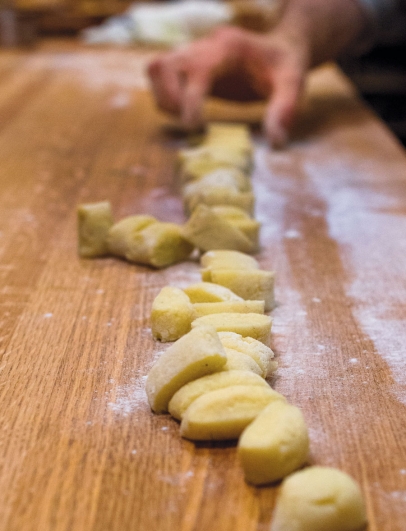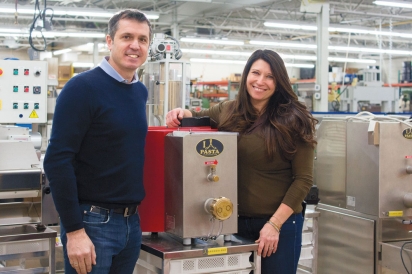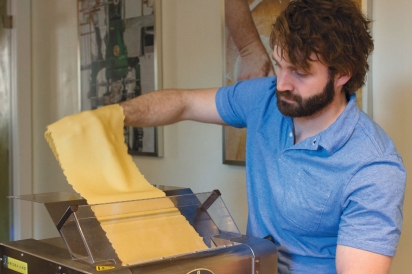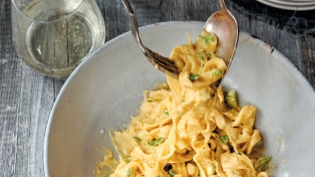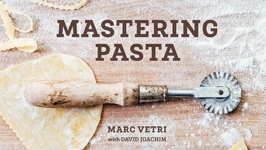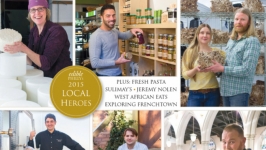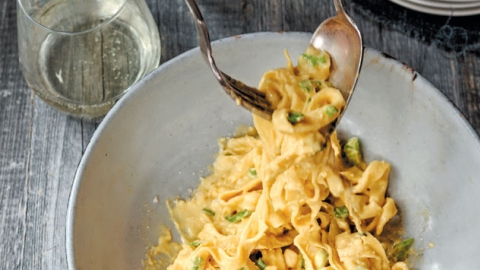Philadelphia & the Fresh Pasta Revolution
How one local company changed Italian restaurants around the country
The best pasta I ever ate was almost completely naked. The paccheri, a tube shaped noodle, had been plucked from its pot with a slotted spoon, slid directly onto the wooden counter upstairs at Vetri, and sprinkled with a few rough clumps of Parmigiano Reggiano.
Still dripping from its boil, it nearly burned my fingers as I picked it up and popped it in my mouth. An assortment of flavors poked through the pungent saltiness of the grated cheese. The pasta was earthy, almost smoky, and at the same time tasted sweet.
I didn’t know it yet, but it tasted like ... wheat.
“Yes, we make wheat-flavored pasta here,” joked Adam Leonti, Vetri’s chef de cuisine, as I tried to describe the experience. Leonti was the creator—along with mentor and head chef Marc Vetri—of the noodle I’d just sucked down.
Flavored pastas are a real thing, but the joke was that this batch had been made with nothing but water and flour. Pasta is always made from wheat—it just doesn’t always taste that way. The rich, golden-brown ring of densely textured dough was certainly nothing like the spaghetti and meatballs I’d grown up with.
“It breaks my heart when I see people boiling pasta to death, throwing it on a plate and dumping any old sauce on top,” Vetri writes in his new cookbook, Mastering Pasta (see sidebar page 33). “That is not a proper dish of pasta. That is more like Cheez Whiz on French fries.”
A pasta-focused cookbook is something Vetri has wanted to publish for more than a decade, but 10 years ago, no publisher would pick it up. As it turns out, the delay could be seen as an illustration of the maxim, “all things happen for a reason.” In the ensuing years, Vetri’s knowledge and understanding of pasta grew by leaps and bounds.
Recently, that knowledge has infiltrated kitchens across Philadelphia. The city is in the midst of a serious house-made pasta boom. Look at a selection of menus from top Italian and New American restaurants in Philly today, and there’s a good chance you’ll find at least a couple of dishes featuring pasta made fresh in house.
If you peek into many of those kitchens, you’ll find another similarity: an elegant brass and stainless steel machine, the extruder from whose mandibles those noodles emerge. More often than not, emblazoned on the side is a lilting, lyrical brand name: Arcobaleno.
Arcobaleno is the only full-service pasta machine manufacturer in North America, and its headquarters happen to be in Lancaster.
It’s pretty much impossible not to like Arcobaleno’s husband-and-wife owners, Maja and Antonio Adiletta. Maja is vivaciously gorgeous, but still somehow down to earth, while Antonio is witty and self-assured. Together, they’ve raised six kids, which possibly speaks more about the strength of their relationship than the success of their two-decade-strong business does.
In Italian, Arcobaleno means rainbow, and the company takes its name from the couple’s breakthrough product: a machine that makes multi-color-striped sheets of pasta. That value-adding task was previously only accomplished by hand, and automating the process was an industry innovation. The Adilettas patented their design in 1997.
Antonio is the one who came up with that design—he’s a mechanical engineer by trade (though he later added a business degree)—and Maja is the one who sold it to potential customers. Thanks to her efforts, artisanal pasta purveyors like Monterey Pasta, Valley Fine Foods, San Marco, P&S Ravioli and Joseph’s Gourmet Pasta bought into Arcobaleno’s line of dough rollers, shapers and wrappers (e.g. ravioli-makers), and soon the bulk of Arcobaleno’s business was coming from the United States.
At the time, the company was in Vancouver, which is where the pair first met. Born in Croatia, Maja emigrated to Canada with her father as a young girl, while Italy native Antonio didn’t arrive until years later, when he moved across the world to manage the Vancouver office of an Italian pasta machine manufacturer. Soon after they met, they began working together, with Maja applying her marketing background to help Antonio grow his client list.
As he sold and serviced Italian-made machines, Antonio noticed an asymmetry between the fast-paced, always-on environment of his US and Canadian customers, and the comparatively lackadaisical modus operandi of his European home base.
“In Italy, they’re constantly on vacation, on strike, on holiday, or paid time off,” he observes. “Here, it’s different. Everyone depends on their own production, so if you can’t supply a part right away, or service a machine quickly, it’s going to cause problems.”
That Euro-American dichotomy is still in effect today. Shola Olunloyo of Studiokitchen, who was one of Arcobaleno’s first chef clients and still does consulting for the company, points to the cultural split as a major factor in the Adilettas’ success.
“A domestic manufacturing location offers quick service and support, as opposed to waiting weeks for a return phone call from Italy if you buy an imported machine,” he says, adding, with an implied smirk: “Although, that does give you enough time to find a translator.”
Recognizing the potential to exploit this cross-Atlantic divide, Maja and Antonio decided to go out on their own. Using money from a mortgage on Maja’s parents’ house, they incorporated in 1995, and bought a small machine shop. It was 2,500 square feet, one-tenth the size of their current facility, but it was enough to get started.
Their first sale was for a ravioli machine that Antonio built from scratch. It was a progenitor to their current products, with all of the characteristics Arcobaleno would become known for: an open design that’s easy to monitor, tool-free disassembly for easy cleaning, and the PLC (programmable logic controller) interface. This last part was extremely novel for the time; 20 years ago, Arcobaleno was making pasta machines run by a computer. It would take the rest of the industry nearly 15 years to catch up.
“Everyone in our market was, like, just keep it mechanical, don’t digitize it. But we couldn’t help it—it made sense. And you know what? It caught on.” Maja laughs, remembering that in the ‘90s (and for many years afterward), Italian-made machines required customers to use a wrench to adjust critical factors like speed and timing. On Arcobaleno’s product, then as now, users could make changes electronically just by pressing a few buttons.
These innovations, along with a zest for customer service and a willingness to make modifications and customizations per client requests, led to huge growth in sales. Most of it was in the urbane markets in California and along the U.S. East Coast, where fresh pasta was a surging gourmet grocery trend.
At the turn of the millennium, Maja and Antonio realized that if their company was going to continue to grow, they needed to move closer to their core market. If they moved Arcobaleno to the States, they’d not only save on cross-continent shipping costs, they’d also be more accessible, to both current and potential future customers.
They began searching for new locations. In the end, it was lunch with the Governor that landed them in Pennsylvania.
Governor Tom Ridge was slated to visit Toronto, and his economic development team set up a small luncheon for him to woo leaders of companies that were considering relocating to his state. Along with heads of giants like Weston, Novacare and Bombardier, the Adilettas were asked to join. They jumped at the chance, booking flights the very same day they received the invite.
“The Governor was great,” Maja recalls. “He said, ‘What do you need? Where do you want to go?’” Chester County was targeted as a good location, and the Adilettas booked a week’s stay to test the waters. Thanks to the local economic development team, within that one week they ended up with approval for a bank loans, found a facility, and became incorporated in the U.S. By 2002, Arcobaleno was up and running in a 7,500-square-foot warehouse in Downingtown, providing machines to retail pasta makers across America.
And then Marc Vetri came to visit.
It was 2005, and Vetri was planning to open Osteria. He’d used a pasta extruder when cooking in Italy, but since his eponymous original restaurant was so petite, he hadn’t yet seen the need to invest in one. When he and partners Jeff Benjamin and Jeff Michaud decided to turn a sprawling warehouse on North Broad into a much larger high-end Italian dining room, he decided to explore the possibility.
Searching online, Vetri quickly came upon Arcobaleno, then noticed their factory and showroom were located less than an hour away. Time for a mini road trip. He piled into his pickup with Michaud and future chef-partner Brad Spence and drove to Downingtown.
At the time, Arcobaleno was focused on the wholesale market, so their machines were built for bulk. The smallest extruder in the lineup was designed to put out 50 pounds of pasta every hour—at least three times as much as a medium-size restaurant would need for an average night of service.
“Marc said, ‘That’s the smallest machine you have?’” Maja remembers. “He ended up taking it anyway. He still has it to this day.”
Across the seven restaurants in the Vetri Family (Vetri, Osteria, Osteria NJ, Amis, Alla Spina, Pizzeria Vetri and Lo Spiedo) around a dozen Arcobaleno pasta extruders and sheeters of various sizes are now in use. Most of them are smaller than that original model, possible because Vetri’s 2005 visit marked an inflection point in Arcobaleno’s business model.
Happy with his first extruder, Vetri began to spread the word, recommending the company whenever he had a chance. Chefs across the Eastern seaboard started calling the Downingtown factory, all of them requesting one thing: a smaller machine.
“As a good Italian, just to resist, I kept saying, ‘No, we don’t do that,’” Antonio says, smiling. Arcobaleno was doing banner sales of larger-size machines, the 250-lb./hr. and 1,000-lb./hr. models. Business was so good, in fact, that the company outgrew the Downingtown facility and in 2007, relocated to a space in Lancaster with more than triple the footprint.
Though the move would take the Adilettas further away from the city life they craved, it was a good business decision. A machine shop needs skilled tradespeople, and Lancaster’s Thaddeus Stevens College of Technology provided a steady stream of talented workers. Plus, with the extra space, they would be able to extend their line into the more compact machines chefs were calling for. The first appliance produced at the Lancaster facility was the AEX18 extruder. Designed specifically for use in restaurants, it sits on a tabletop and produces approximately 18 pounds of pasta per hour.
It was the machine private and development chef Shola Olunloyo would take home with him in 2010, a pivotal event that Maja remembers as galvanizing Arcobaleno’s connections with chefs.
“I first heard of the Arcobaleno from Shola,” says Alex Talbot of Ideas in Food. “We made pasta together and I was smitten. Soon afterwards, we got a machine and began working through possibilities. I started trumpeting the gospel of pasta extruders. The Arcobaleno machines are built rock solid. Their customer service is second to none.”
Along with wife Aki Kamozawa, Talbot has authored three cookbooks, and the couple’s long-running blog is extremely well respected, so their glowing endorsement has been influential. It was thanks to Talbot and Kamozawa that chef Kevin Sbraga decided to try the brand.
“I went with Arcobaleno because of their reputation and the reliability of the machines, but also because I really liked Maja and Antonio the first time I met them,” Sbraga says. “[The machines] have opened so many doors of opportunity for us at Sbraga, The Fat Ham and Juniper Commons.”
Chef Joe Cicala tells a similar story. At Le Virtu, he had won acclaim for his handmade noodles, but in order to keep growing the Abruzzese restaurant’s pasta program (and extend it to his second kitchen at forthcoming Brigantessa), he added an Arcobaleno sheeter and extruder to his arsenal in July 2013. He found they helped him reduce labor costs—instead of paying someone to cut everything by hand, he could use the machine’s automatic radial cutter—but also offered another benefit: making pasta with a different texture.
“Kneading dough in the machine [as opposed to by hand] helps develop better gluten, and makes a stronger, more elastic pasta, which gives it a nice al dente texture, even when using an egg pasta dough,” Cicala explains.
In Mastering Pasta, Vetri goes into detail about the differences between hand- and machine-kneading and devotes a whole chapter to extruding your own dough. Soon, it will be easier than ever for home cooks to get into the extrusion game. Arcobaleno is about to release its first home pasta extruder.
Designed in collaboration with Vetri (and co-branded with the Vetri name), the machine will be small enough to store and carry around, but strong enough to put out pasta for a dinner party of 12. Vetri already uses a prototype for classes he holds at his upstairs show kitchen.
Vetri also teaches at Drexel’s Center for Hospitality and Sport Management. The West Philly university now has an entire room dedicated to pasta making: the Arcobaleno Pasta Lab.
Set in a 240-square-foot section of a kitchen-classroom, the lab is full of equipment donated by Maja and Antonio. There are extruders and mixers and sheeters and even the company’s new pasta cooker. The facility can be used anytime by students—one man who has a job at Vernick uses it to extrude pasta that he then brings to the restaurant. The room will also serve as a satellite Arcobaleno demonstration kitchen.
“It gives students exposure to these machines,” says Drexel Hospitality and Tourism Program Director Mike Traud, a former lawyer- turned-chef-turned-educator who first fell in love with fresh pasta when he worked at Osteria. “With more and more kitchens using them, it’s a good skill for our graduates to have in their arsenal.”
Universities are more than training grounds; they’re also useful for testing and research. Arcobaleno is currently working with the University of Oregon on machines customized for production of vegan and gluten-free pastas. And Marc Vetri has been collaborating with Dr. Stephen Jones at Washington State University, exploring the subject of different types of wheat.
The “wheat-flavored” pasta Adam Leonti joked about tasted the way it did not only because it was freshly extruded (and then dried), but because it was made from freshly-milled Blue Beard wheat. Inhouse milling hasn’t yet become widespread in the restaurant industry, but, like with extruding, the Vetri crew is at the forefront of the movement.
Flour begins to go stale within days of being milled. It’s similar to what happens with coffee. The less time between grinding your beans and brewing your cup, the more flavor the end result will have. Same goes for grains of wheat.
On the third floor of the Vetri building, I watched Adam Leonti toss a handful of whole grains into a mill. Stone burrs ground them into a mix of coarse and fine flour, which Leonti then sifted using a robot. He mixed the result with some water and egg, kneaded it, and sent it through the Arcobaleno pasta sheeter. Sliced into ribbons, it became pappardelle, which he dropped into boiling water, then transferred into a pan. After swirling them with lots of butter, cheese and a splash of pasta water, he poured them onto a plate.
As I twirled them around my fork and reveled in their flavor, I marveled that fewer than 45 minutes prior, they’d been nothing but a few hard kernels sitting in the palm of my hand.
The Philadelphia pasta revolution has only just begun.


